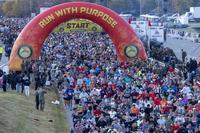Physical decline and aging are natural parts of life, but they are not reasons to begin a sedentary lifestyle. Both are reasons to do just the opposite. What you do now will determine your life over the next decade or two.
We all have the power to manage the slope of our decline, which starts with our choices today, mainly by staying determined to fight aging with consistent activity and healthy choices, such as sleep, nutrition and hydration. For a more in-depth process to increase your longevity, you should read Dr. Peter Attia's best-selling book, "Outlive: The Science and Art of Longevity."
The degree of decline can take the form of a mild, sloping linear progression or, in some cases, a more exponential trend. Many remain active throughout their 50s and 60s with various options that include calisthenics, running, swimming, physical labor (yard work) and stretching. This has enabled them to manage decline at a relatively slight slope.
However, luck plays an important role as well. Accidental injuries, serious illnesses and car accidents can be a driving force to your being unable to stay physically active for significant periods. Any of these occurring after your fourth decade on Earth can make recovery even more challenging.
Recognizing the signs of physical decline early on is key. Often, a combination of time passing and bodily changes triggers this decline. In some cases, a training injury can be the catalyst for a noticeable shift in capabilities and performance.
For me, the decline became apparent in my late 30s, particularly because of an injury that led to a six-month recovery process. I pulled a hamstring at 38 after a poorly timed sprint session. This incident impacted my speed and agility, signaling the beginning of a slower healing and recovery process and the inability to bounce back 100%. This early detection, if you will, and proactive approach to diversify training options have helped me to make this a much milder decline as each decade passes. Read 80% is the new 100% for more ideas to avoid training injuries.
Everyone is different, so the year may be earlier or later for you, but decline is inevitable. This incident was a turning point for speed and agility improvements. Different activities and elements of fitness may decline at different rates.
While many lose their speed and agility first, strength and power can hold up relatively longer. The elements that have the longest shelf life are cardio endurance and muscle stamina. However, for many lifters, muscle strength may diminish more slowly. I've noticed that while my running abilities have been affected, my calisthenics and swimming skills are largely preserved, as these rely more heavily on cardiovascular fitness over joint health. Changes due to aging are inevitable, and one could expect to notice changes before reaching 40 years of age.
Strategic training practices, such as the tactical fitness periodization I've been following for about 20-plus years, are not just a game-changer. They are a lifeline in managing physical decline. Consider this type of training as more of a fitness budget that creates different cycles throughout the year, allowing you to maintain the needed elements of fitness.
Optimizing the balance between strength training, calisthenics conditioning and cardiovascular activities across different year periods significantly impacts maintaining a more progressive decline. This approach helps to create a system of peaks and valleys throughout the year, adjusting as the seasons change and extending the period of peak physical performance across the board of needed attributes. These are strength, power, speed, agility, endurance, muscle stamina, flexibility, mobility and balance/stability.
Regardless, it's crucial to note that physical decline will occur, and having a consistent plan and program to manage it is the answer. Ultimately, taking a conscious approach to training and activity can help minimize this decline throughout the "golden years" and extend the period of physical activity.
Your future rate of decline depends on your current actions. Physically, this could produce a slow-moving, linear decline or, more drastically, an exponential one. At 55, I still find myself in the mild sloping "linear decline" category due to my consistent activity. It's a gradual decline, given that I'm not as swift as I used to be in running and sprinting, but it is far from a steep drop. This trajectory makes all the difference in building a foundation for longevity to grow. A more sedentary lifestyle can morph you into a rapid decline. If you want to battle this decline with success, faithfully follow a program of any physical activity daily.
Physical activity can be described as walking, yard work, biking, swimming, playing sports such as Pickleball or whatever you enjoy; just be consistent with it. It does not have to mean joining a gym, but doing activities that help you save muscle (strength) will determine how you live your last decade.
Want to Learn More About Military Life?
Whether you're thinking of joining the military, looking for fitness and basic training tips, or keeping up with military life and benefits, Military.com has you covered. Subscribe to Military.com to have military news, updates and resources delivered directly to your inbox.


















